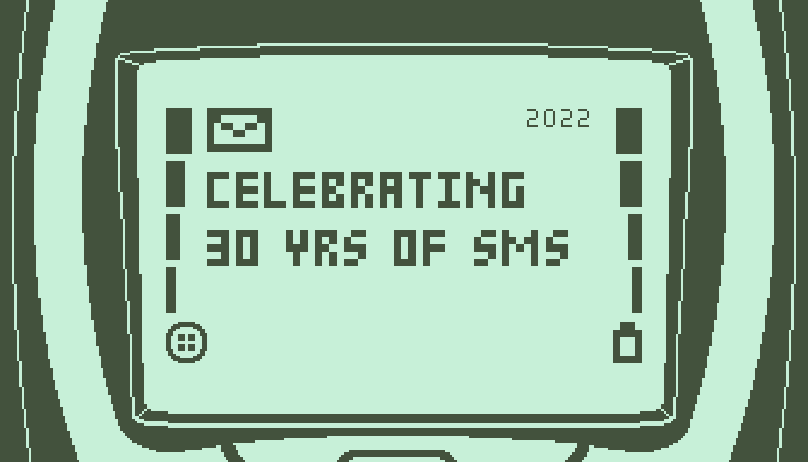Celebrating 30 Years of SMS (and Our Predictions for What's to Come)
Time to read:

Every year, like clockwork, the team prepares for a weekend of tremendous retail fanfare. But this year when Black Friday and Cyber Monday had passed, the real party had arrived at last. After all, this year marks the 30th anniversary of the first SMS; and what we’d do without it, is anyone’s guess.
Twenty years after the first mobile phone call, the first text message, a simple “Merry Christmas.” was sent by Neil Papworth, a 22-year-old software developer from the United Kingdom. From T9 on a Motorola Razr to an app on your favorite smartphone, to verification, marketing messages, and even sales conversations – it’s hard not to be in awe of the innovation that took place since that first text (and we’re not just talking about emojis 😂).
Needless to say, when we first launched the Twilio SMS API in 2010, we couldn’t have predicted the level of innovation that millions of developers would power with this “ridiculously simple” way to send messages around the world. Today, developers on Twilio’s Customer Engagement Platform send more than 140 billion messages every year on a Messaging platform powering reliability at scale.
As we look ahead to the next 30 years, we couldn’t be more excited for what’s to come – here are our top trends for the year ahead.
#1: SMS Marketing will continue to take the world by storm
According to The Growth Report 2022 by Twilio Segment, 69% of businesses say they are leaning into channels with proven ROI, while increasingly focusing on retention and loyalty over acquisition. And, although the cookieless future has been delayed a bit longer, Apple’s App Tracking Transparency (ATT) framework is here today and dramatically impacting how marketers are thinking about their strategies. In fact, according to the 2022 State of Customer Engagement Report that surveyed thousands of enterprise decision makers and consumers globally, 71% of companies expect a cookieless world will result in lower return on ad spend and decreased ability to measure campaign efficacy.
Cyber Week 2022 underscored just how valuable owned channels like email, SMS, and WhatsApp can be, with email volumes topping 50 billion and nearly 4 billion messages (a 24% increase year-over-year) delivered on the Twilio Customer Engagement Platform. Personalization and innovation in targeting with first-party data will only drive usage and efficiency of these channels in the years to come.
#2: Trust will drive loyal relationships
Our phones are home to some of the most important conversations, photos, videos, and scroll-inducing content out there. The privilege of landing on a consumers’ lock screen is not one that comes easily and requires constant maintenance of trust. As messaging continues to grow, respecting consumer preferences, ensuring opt-in and opt-out compliance, verifying senders for delivery on Application-to-Person is critical. Forty percent of consumers say they’ll cut off communication with a brand that breaks their trust by unsubscribing and 38% say they’ll stop purchasing from that company.
Maintaining that trust also means personalizing digital communications to build relationships with consumers on their terms. And in 2023, personalization will mean more than just a “hi, {First Name}”. It's increasingly about delivering messages over preferred channels and providing relevant content based on first-party data. The benefit is clear: on average, consumers spend 46% more when engagement is personalized.
#3: MMS will power experiences that convert
A key lesson for many businesses over the past few years has been the need to deliver relevance and not noise to consumers. Since 75% of consumers surveyed said they’ve received a digital communication from a business in the past 24 hours, standing out on a lock screen is becoming more critical. That means delivering more timely, relevant, and engaging communications. MMS, the sibling of SMS, enables businesses to send images, video, longform text messages, contact cards, and have group conversations.
We expect MMS (where supported by the Industry) to play a larger role in delivering engaging digital communications for everything from text marketing to sales conversations. For regions where other messaging channels like WhatsApp are dominant, interactive features and media are already driving higher engagement rates. Because consumers are global, and have unique expectations depending on the messaging channel, it’s important to consider how to create consistent experiences across channels, without the need for more code.
#4: Consumers will look for conversations in moments of need
While much of business messaging started as a way to get critical information in the hands of consumers, there’s a massive opportunity to evolve to conversational messaging. The 2022 Conversational Messaging trend report surveyed nearly 4,000 consumers across 10 countries and found 77% of consumers want to use conversational messaging to get help with selecting a product or service, and 58% would use messaging channels to purchase a product or service if they had the option.
Conversational, two-way messaging has the potential to unlock new revenue for businesses, build lifelong relationships with customers, and create a consistent experience across distributed storefronts, from retail stores to websites and mobile apps.
To celebrate, we got you something…
There you have it: our top trends in messaging for 2023 and beyond. We can’t wait for the innovation to come in the next 30 years and to support the builders delivering customer engagement – 160 characters at a time.
To celebrate, we built a game, Message Sent, paying homage to SMS and the early devices that sent them. Check it out!
Related Posts
Related Resources
Twilio Docs
From APIs to SDKs to sample apps
API reference documentation, SDKs, helper libraries, quickstarts, and tutorials for your language and platform.
Resource Center
The latest ebooks, industry reports, and webinars
Learn from customer engagement experts to improve your own communication.
Ahoy
Twilio's developer community hub
Best practices, code samples, and inspiration to build communications and digital engagement experiences.


